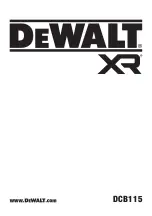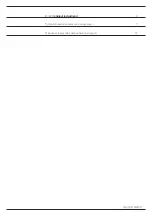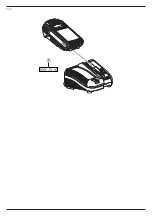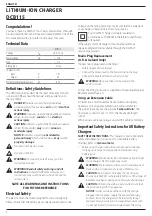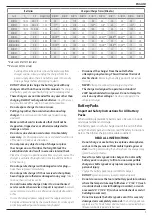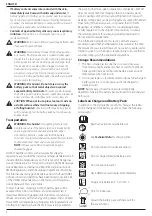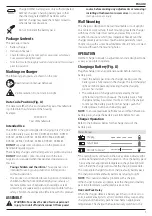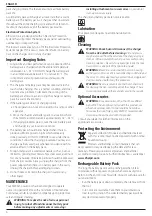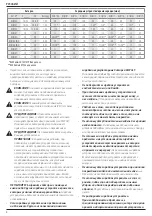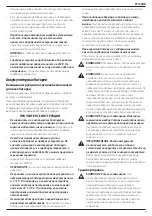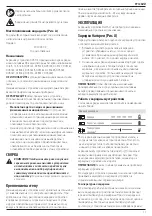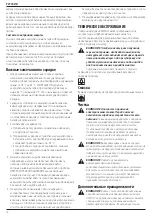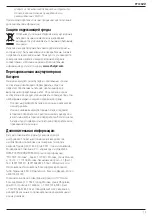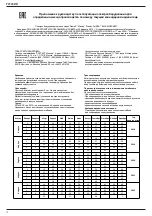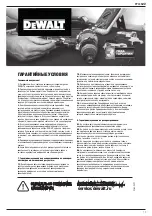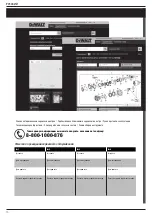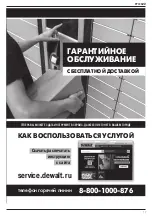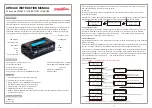
3
English
Batteries
Chargers/Charge Times (Minutes)
Cat #
V
DC
Ah
Weight (kg) DCB104
DCB107 DCB112 DCB113 DCB115 DCB116
DCB117 DCB118 DCB132 DCB119
DCB546
18/54
6.0/2.0
1.05
60
270
170
140
90
80
40
60
90
X
DCB547
18/54
9.0/3.0
1.46
75*
420
270
220
135*
110*
60
75*
135*
X
DCB548
18/54
12.0/4.0
1.44
120
540
350
300
180
150
80
120
180
X
DCB181
18
1.5
0.35
22
70
45
35
22
22
22
22
22
45
DCB182
18
4.0
0.61
60/40**
185
120
100
60
60/45** 60/40** 60/40**
60
120
DCB183/B/G
18
2.0
0.40
30
90
60
50
30
30
30
30
30
60
DCB184/B/G
18
5.0
0.62
75/50**
240
150
120
75
75/60** 75/50** 75/50**
75
150
DCB185
18
1.3
0.35
22
60
40
30
22
22
22
22
22
40
DCB187
18
3.0
0.54
45
140
90
70
45
45
45
45
45
90
DCB189
18
4.0
0.54
60
185
120
100
60
60
60
60
60
120
*Date code 201811475B or later
**Date code 201536 or later
Batteries
Chargers/Charge Times (Minutes)
Cat #
DC
Weight
*Date code 201811475B or later
**Date code 201536 or later
buildup of metallic particles should be kept away from
charger cavities. Always unplug the charger from the
power supply when there is no battery pack in the cavity.
Unplug charger before attempting to clean
•
DO NOT attempt to charge the battery pack with any
chargers other than the ones in this manual.
The charger
and battery pack are specifically designed to work together.
•
These chargers are not intended for any uses other than
charging
D
e
WALT
rechargeable batteries.
Any other uses
may result in risk of fire, electric shock or electrocution.
•
Do not expose charger to rain or snow.
•
Pull by plug rather than cord when disconnecting
charger.
This will reduce risk of damage to electric plug
and cord.
•
Make sure that cord is located so that it will not be
stepped on, tripped over, or otherwise subjected to
damage or stress.
•
Do not use an extension cord unless it is absolutely
necessary.
Use of improper extension cord could result in risk
of fire,electric shock, or electrocution.
•
Do not place any object on top of charger or place
the charger on a soft surface that might block the
ventilation slots and result in excessive internal heat.
Place the charger in a position away from any heat source. The
charger is ventilated through slots in the top and the bottom
of the housing.
•
Do not operate charger with damaged cord or plug—
have them replaced immediately.
•
Do not operate charger if it has received a sharp blow,
been dropped, or otherwise damaged in any way.
Take it
to an authorised service centre.
•
Do not disassemble charger; take it to an authorised
service centre when service or repair is required.
Incorrect
reassembly may result in a risk of electric shock, electrocution
or fire.
• In case of damaged power supply cord the supply cord must
be replaced immediately by the manufacturer, its service agent
or similar qualified person to prevent any hazard.
•
Disconnect the charger from the outlet before
attempting any cleaning. This will reduce the risk of
electric shock.
Removing the battery pack will not reduce
this risk.
•
NEVER
attempt to connect two chargers together.
•
The charger is designed to operate on standard
230V household electrical power. Do not attempt to
use it on any other voltage.
This does not apply to the
vehicular charger.
Battery Packs
Important Safety Instructions for All Battery
Packs
When ordering replacement battery packs, be sure to include
catalogue number and voltage.
The battery pack is not fully charged out of the carton. Before
using the battery pack and charger, read the safety instructions
below. Then follow charging procedures outlined.
READ ALL INSTRUCTIONS
•
Do not charge or use battery in explosive atmospheres,
such as in the presence of flammable liquids, gases or
dust.
Inserting or removing the battery from the charger may
ignite the dust or fumes.
•
Never force battery pack into charger. Do not modify
battery pack in any way to fit into a non-compatible
charger as battery pack may rupture causing serious
personal injury.
• Charge the battery packs only in
D
e
WALT
chargers.
•
DO NOT
splash or immerse in water or other liquids.
•
Do not store or use the tool and battery pack in locations
where the temperature may fall below 4 ˚C (34 ˚F) (such
as outside sheds or metal buildings in winter), or reach
or exceed 40 ˚C (104 ˚F) (such as outside sheds or metal
buildings in summer).
•
Do not incinerate the battery pack even if it is severely
damaged or is completely worn out.
The battery pack can
explode in a fire. Toxic fumes and materials are created when
lithium-ion battery packs are burned.
Содержание XR DCB115
Страница 1: ...DCB115 ...
Страница 3: ...1 Fig A 1 ...
Страница 28: ...26 Українська ...
Страница 29: ...27 Українська ...
Страница 30: ......
Страница 31: ......
Страница 32: ...530916 05 RUS UA 05 21 ...

